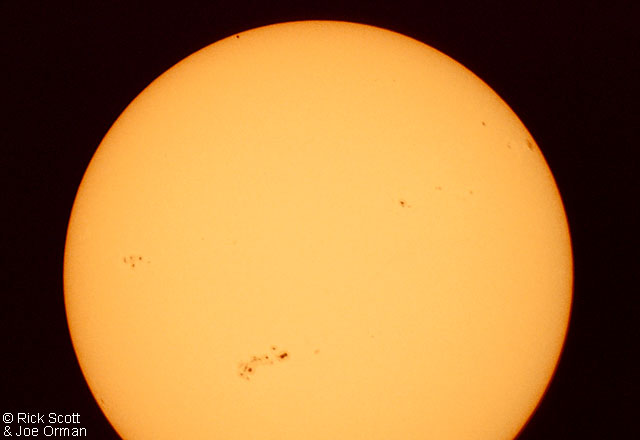
|
Credit & Copyright: Rick Scott and Joe Orman
Explanation:
OK, it's a picture of the Sun (duh!),
but can you
spot the planet?
Of course, most of the spots you've spotted are sunspots,
as large or larger than planet Earth itself.
The sunspots are
regions of strong surface magnetic fields which
are dark in this picture only because they are relatively cool
compared to their surroundings.
Over the past few years,
the number of sunspots
has been steadily increasing
as the Sun approaches the maximum in its 11 year activity cycle.
But
also
visible in
this photograph from November 15,
is planet Mercury.
At just over 1/3 Earth's size, Mercury
is passing in front of the Sun, its silhouette briefly creating
a diminutive dark spot
drifting across an enormous solar disk.
While "transits" of Mercury
do occur 13 times a century, this one
was additionally a very rare grazing transit of our
Solar System's innermost planet.
Spotted Mercury yet? Click on the picture for a hint.
|
January February March April May June July August September October November December |
| ||||||||||||||||||||||||||||||||||||||||||||||||
NASA Web Site Statements, Warnings, and Disclaimers
NASA Official: Jay Norris. Specific rights apply.
A service of: LHEA at NASA / GSFC
& Michigan Tech. U.
Based on Astronomy Picture
Of the Day
Publications with keywords: planet - Mercury - transit - sunspot
Publications with words: planet - Mercury - transit - sunspot
See also:
- MESSENGER s Last Day on Mercury
- APOD: 2025 March 16 Á Venus and the Triply Ultraviolet Sun
- APOD: 2024 September 16 Á Mercurys Vivaldi Crater from BepiColombo
- APOD: 2024 May 13 Á AR 3664 on a Setting Sun
- APOD: 2024 May 11 Á AR 3664: Giant Sunspot Group
- APOD: 2023 July 11 Á Sunspots on an Active Sun
- APOD: 2023 May 17 Á Sunspot with Light Bridge
